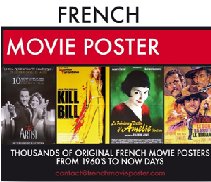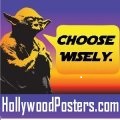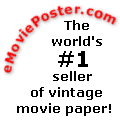The most widely used movie art is the one sheet. Up
until approximately 1984, the one sheet measured 27" x 41" (normally with
a border). Since the mid 1980ís, some one-sheets
measure 27" x 40" (normally without a border). They are normally
printed on paper and displayed in a marquee case.
Click HERE for
Size Comparison
HISTORY
The one sheet was introduced and standardized
in 1909 by Thomas Edisonís Motion Picture Patents Company. The one sheet
measured 27" x 41" and was printed by a very select group of
lithographers. It was first printed via
a stone lithography process which offered beautiful soft tones. With the
loss of stone quarries during World War I, lithographers substituted lime
stone which did not produce the soft tones of stone. By the 1930ís, offset
printing was introduced, and movie posters began to take the look of the
times.
By the mid-1970ís, paper changed and the movie poster
went from a cheaper grade paper to one that was clay coated, giving a
glossy, shiny finish to the poster. Posters on the clay coated paper have
a smooth feel to the touch while non-clay coated paper has a coarser feel.
The one sheet is still widely used by movie studios
in their advertising campaigns. While some 27" x 41" size one
sheets are still being issued, the trend appears to be to downsize it
to 27" x 40", eliminating the borders. By setting the size at 27" x 40",
the artwork can cover the poster from edge to edge.
There is also an increase in the number of posters
being released with reverse print on the back side. This is known as double
sided printing. While they are a lot more expensive to print, they
can be displayed in light boxes which gives then a three-dimensional effect.
AS A COLLECTIBLE
Arguably the one sheet is still the most sought-after
size and style of movie art among collectors. It is the centerpiece of
the movie paper industry, and normally commands the highest dollar in
relation to other sizes and styles. While most collectors still pursue
the older titles, there is a wave of new collectors who seek newer posters,
particularly those posters that are unique in some way. For example, double-sided
posters, lenticular posters, mylar posters or other special effects/events
are extremely desirable among the newer collectors.





